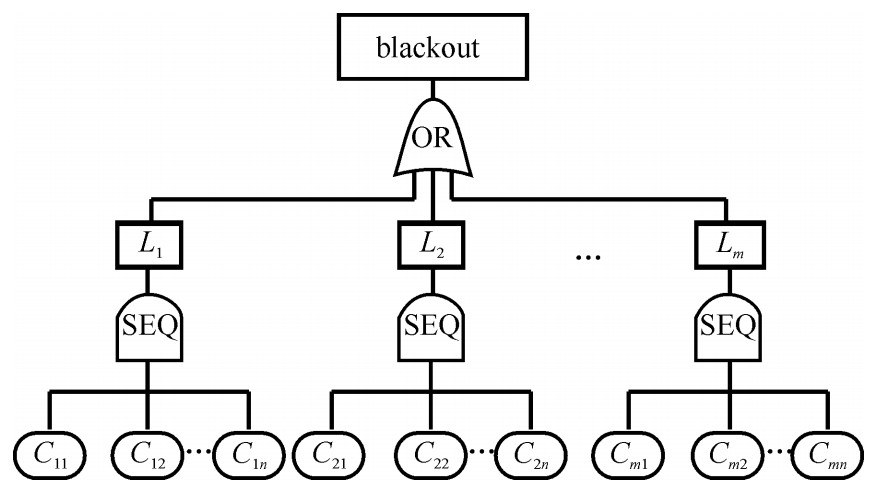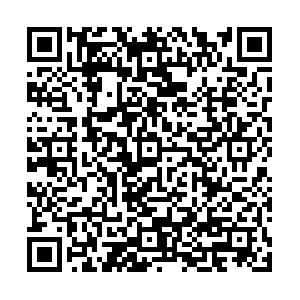Power system fault chain simulation model considering effect of geomagnetic storm
-
摘要: 地磁暴影响下地磁感应电流(GIC) 流过变压器中性点, 引起变压器无功损耗增加, 在强地磁暴环境中, 系统的无功补偿装置可能过载, 母线电压下降, 可能引发连锁故障, 继而导致大停电事故。对比事故链各环节特点和因磁暴导致的电力系统停电事故的发展规律, 使用事故链模型来仿真实现地磁暴条件下的电网停电过程。基于自组织临界理论和非故障线路的安全稳定裕度来确定连锁故障的传播路径。结合IEEERTS79系统参数, 估算各母线的地理位置, 借助PowerWorld仿真软件, 以该系统为例, 研究结果验证了所提事故链模型可以反映给定电网条件下, 地磁暴参数对电力系统事故链集与薄弱环节辨识的影响, 研究结果可为量化和防治磁暴电网灾害提供依据。Abstract: In the condition of strong magnetic storm, geo-magnetically induced current (GIC) flowing through the neutral point of the transformer, causes the increase of reactive power loss of the transformer.This might lead to overload of the reactive power compensation device, drop of the bus voltage and occurrence of a chain fault, which in turn causes a blackout of the system.Comparing the characteristics of each link in the fault chain and the development law of the power system blackout caused by magnetic storms, the fault chain model is used to simulate the process of power outage under conditions of geomagnetic storm.The article determines the propagation path of cascading failures based on the self-organizing critical theory and the safety margin of non-faulty circuits.Combining the IEEE-RTS 79 system parameters, the geo-location of each bus is estimated.Taking this system as an example and using Power World simulator, the research results verify that the proposed model can reflect the geomagnetic storm parameters against the power system fault chains and the identification of weak links under given grid conditions.The research results can provide a basis for quantifying and preventing disasters in the magnetic storm condition.
-
Key words:
- geo-magnetic storm /
- fault chain model /
- self-organized critical theory /
- stability margin /
- weak links
-
表 1 IEEE-RTS79系统各母线的地理位置
Table 1. Estimated geo-location of IEEE-RTS79
No. latitude/(°) longitude/(°) No. latitude/(°) longitude /(°) 1 45.276 7 113.770 5 13 45.742 8 114.732 7 2 45.319 9 113.765 8 14 45.390 7 115.061 5 3 45.005 7 114.560 6 15 45.174 2 115.180 3 4 45.094 7 114.188 9 16 45.224 9 115.450 2 5 45.320 4 114.133 9 17 45.192 9 115.133 6 6 45.553 7 114.507 8 18 45.199 2 115.397 0 7 45.451 7 113.608 0 19 45.398 1 115.235 7 8 45.329 6 113.810 7 20 45.75 9 115.405 0 9 45.366 3 114.526 0 21 45.415 9 115.680 5 10 45.366 3 114.526 0 22 46.022 5 115.833 5 11 45.366 3 114.526 0 23 45.932 2 115.590 0 12 45.366 3 114.526 0 24 45.005 7 114.360 6 表 2 初始故障的设定
Table 2. Initial failure setting
geomagnetic data SOC lines γi E=0 L10(B6-10)
L25(B15-21)
L23(B14-16)1.547 0
1.361 6
1.165 9E=12 V/km,130° L10(B6-10)
L25(B15-21)
L23(B14-16)1.496 1
1.347 1
1.153 4E=12 V/km,46° L10(B6-10)
L25(B15-21)
L7(B3-24,T)
L23(B14-16)1.480 7
1.340 2
1.193 3
1.152 1表 3 不同磁暴条件下系统的事故链集
Table 3. Fault chain sets
geomagnetic data No. fault chains E=0 1 L10-L5-L25-L29 2 L25-L23-L30-L28-L34-L37 3 L23-L29 E=12 V/km,130° 4 L10-L5-L25-L29 5 L10-L5-L25-L30-L33-L28-L34 6 L25-L23-L30-L28-L34-L37 7 L23-L29 8 L23-L7(T) E=12 V/km,46° 9 L10-L5-L25-L29 10 L10-L5-L25-L30-L33-L28 11 L25-L28-L30-L28-L34 12 L7(T)- L23 13 L7(T)-L6-L2-L28-L23 14 L7(T)-L28-L24-L25-L33-L34 15 L23-L29 表 4 事故链13的生成过程
Table 4. Process of fault chain 13
fault line non-faulty line si L7(B3-24,T) L6(B3-9) 1.1102 L6(B3-9) L2(B1-3) 1.0328 L2(B1-3) L28(B14-16) 1.0293 L28(B14-16) L23(B14-16) 1.0565 L23(B14-16) blackout — -
[1] 刘文颖, 杨楠, 张建立, 等. 计及恶劣天气因素的复杂电网连锁故障事故链模型[J]. 中国电机工程学报, 2012, 32(7): 53-59. https://www.cnki.com.cn/Article/CJFDTOTAL-ZGDC201207008.htmLiu Wen-ying, Yang Nan, Zhang Jianli, et al. Complex grid failure propagating chain model in consideration of adverse weather. Proceedings of the CSEE, 2012, 32(7): 53-59 https://www.cnki.com.cn/Article/CJFDTOTAL-ZGDC201207008.htm [2] 刘连光, 吴伟丽. 磁暴影响电力系统安全风险评估思路与理论框架[J]. 中国电机工程学报, 2014, 34(10): 1583-1591. doi: 10.13334/j.0258-8013.pcsee.2014.10.009Liu Lianguang, Wu Weili. Security risk assessment ideas and theoretical framework for power system considering geomagnetic storm. Proceedings of the CSEE, 2014, 34(10): 1583-1591 doi: 10.13334/j.0258-8013.pcsee.2014.10.009 [3] Boteler D H. Geomagnetic hazards to conducting networks[J]. Natural Hazards, 2003, 28(2-3): 537-561. [4] 罗毅, 王英英, 万卫, 等. 电网连锁故障的事故链模型[J]. 电力系统自动化, 2009, 33(24): 1-5. https://www.cnki.com.cn/Article/CJFDTOTAL-DLXT200924002.htmLuo Yi, Wang Yingying, Wan Wei, et. al. Fault chains model for cascading failure of grid. Automation of Electric Power Systems, 2009, 33(24): 1-5 https://www.cnki.com.cn/Article/CJFDTOTAL-DLXT200924002.htm [5] 顾雪平, 刘雨濛, 王涛, 等. 基于结构平衡理论的电网自组织临界态辨识[J]. 电工技术学报, 2018, 33(17): 1-10. https://www.cnki.com.cn/Article/CJFDTOTAL-DGJS201817022.htmGu Xueping, Liu Yumeng, Wang Tao, et al. Self-organized critical state identification of power systems based on structural equilibrium theory. Transactions of China Electrotechnical Society, 2018, 33(17): 1-10 https://www.cnki.com.cn/Article/CJFDTOTAL-DGJS201817022.htm [6] Zhu Z Q, Wu L J, Xia Z P. An accurate subdomain model for magnetic field computation in slotted surface-mounted permanent-magnet machines[J]. IEEE Trans Magnetics, 2010, 46(4): 1100-1115. doi: 10.1109/TMAG.2009.2038153 [7] 何飞, 梅生伟, 薛安成, 等. 基于直流潮流的电力系统停电分布及自组织临界性分析[J]. 电网技术, 2006, 30(14): 7-12. doi: 10.3321/j.issn:1000-3673.2006.14.002He Fei, Mei Shengwei, Xue Ancheng, et al. Blackout distribution and self-organized criticality of power system based on DC power flow. Power System Technology, 2006, 30(14): 7-12 doi: 10.3321/j.issn:1000-3673.2006.14.002 [8] 岳贤龙, 王涛, 顾雪平, 等. 基于自组织临界理论的电网脆弱线路辨识[J]. 电力系统保护与控制, 2016, 44(15): 18-26. https://www.cnki.com.cn/Article/CJFDTOTAL-JDQW201615003.htmYue Xianlong, Wang Tao, Gu Xueping, et al. Vulnerable line identification of power grid based on self-organizing critical theory. Power System Protection and Control, 2016, 44(15): 18-26 https://www.cnki.com.cn/Article/CJFDTOTAL-JDQW201615003.htm [9] Overbye T J, Hutchins T R, Shetye K, et al. Integration of geomagnetic disturbance modeling into the power flow: A methodology for large-scale system studies[C]//IEEE North American Power Symposium. 2012: 1-7. [10] 于群, 郭剑波. 我国电力系统停电事故自组织临界性的研究[J]. 电网技术, 2006, 30(6): 1-5. https://www.cnki.com.cn/Article/CJFDTOTAL-DWJS200606001.htmYu Qun, Guo Jianbo. Study on self-organized criticality of power system blackouts in China. Power System Technology, 2006, 30(6): 1-5 https://www.cnki.com.cn/Article/CJFDTOTAL-DWJS200606001.htm [11] Carreras B A, Lynch V E, Dobson I, et al. Dynamics, criticality and self-organization in a model for blackouts in power transmission systems[C]//IEEE Hawaii International Conference on System Sciences. 2002, 9: 1-9. [12] 吴伟丽. 磁暴诱发电网故障灾害风险分析研究进展[J]. 科学技术与工程, 2016, 16(9): 135-141. https://www.cnki.com.cn/Article/CJFDTOTAL-KXJS201609022.htmWu Weili. Review of risk analysis for severe grid accident due to geomagnetic storm. Science Technology and Engineering, 2016, 16(9): 135-141 https://www.cnki.com.cn/Article/CJFDTOTAL-KXJS201609022.htm [13] 王英英. 基于事故链的电力系统连锁故障风险评估与预防控制研究[D]. 武汉: 华中科技大学, 2010.Wang YingYing. Risk assessment and prevention control of cascading failures in power system based on fault chains. Wuhan: Huazhong University of Science & Technology, 2010 [14] 宋毅, 王成山. 一种电力系统连锁故障的概率风险评估方法[J]. 中国电机工程学报, 2009, 29(4): 27-33. https://www.cnki.com.cn/Article/CJFDTOTAL-ZGDC200904006.htmSong Yi, Wang Chengshan. A probabilistic risk assessment method for cascading failure of power system. Proceedings of the CSEE, 2009, 29(4): 27-33 https://www.cnki.com.cn/Article/CJFDTOTAL-ZGDC200904006.htm [15] 刘友波, 胥威汀, 丁理杰, 等. 电力系统连锁故障分析理论与应用(二): 关键特征与研究启示[J]. 电力系统保护与控制, 2013, 41(10): 146-155. https://www.cnki.com.cn/Article/CJFDTOTAL-JDQW201310027.htmLiu Youbo, Xu Weiting, Ding Lijie, et al. Power system cascading failure analysis theories and application Ⅱ: Key features of real cascading failures and revelation aspects. Power System Protection and Control, 2013, 41(10): 146-155 https://www.cnki.com.cn/Article/CJFDTOTAL-JDQW201310027.htm [16] Dobson I, Chen J, Thorp J S, et al. Examining criticality of blackouts in power system models with cascading events[C]//IEEE Hawaii International Conference on System Sciences. 2002, 10: 1-10. -





 下载:
下载:



